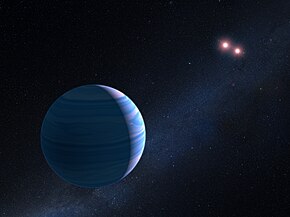
OGLE-2005-BLG-390L is a star thought to be a spectral type M. This dim magnitude 16 galactic bulge star is located in the Scorpius constellation at a far distance of about 21,500 light years.
OGLE-2005-BLG-169Lb is an extrasolar planet located approximately 2,700 parsecs away in the constellation of Sagittarius, orbiting the star OGLE-2005-BLG-169L. This planet was discovered by the OGLE project using the gravitational microlensing method. Based on a most likely mass for the host star of 0.49 solar mass (M☉), the planet has a mass of 13 times that of Earth (ME). Its mass and estimated temperature are close to those of Uranus. It is speculated that this planet may either be an ice giant like Uranus, or a "naked super-Earth" with a solid icy or rocky surface.

A circumbinary planet is a planet that orbits two stars instead of one. The two stars orbit each other in a binary system, while the planet typically orbits farther from the center of the system than either of the two stars. In contrast, circumstellar planets in a binary system have stable orbits around one of the two stars, closer in than the orbital distance of the other star. Studies in 2013 showed that there is a strong hint that a circumbinary planet and its stars originate from a single disk.

An exoplanet is a planet located outside the Solar System. The first evidence of an exoplanet was noted as early as 1917, but was not recognized as such until 2016; no planet discovery has yet come from that evidence. What turned out to be the first detection of an exoplanet was published among a list of possible candidates in 1988, though not confirmed until 2003. The first confirmed detection came in 1992, with the discovery of terrestrial-mass planets orbiting the pulsar PSR B1257+12. The first confirmation of an exoplanet orbiting a main-sequence star was made in 1995, when a giant planet was found in a four-day orbit around the nearby star 51 Pegasi. Some exoplanets have been imaged directly by telescopes, but the vast majority have been detected through indirect methods, such as the transit method and the radial-velocity method. As of 1 June 2024, there are 5,742 confirmed exoplanets in 4,237 planetary systems, with 904 systems having more than one planet. This is a list of the most notable discoveries.

OGLE-2016-BLG-1195Lb is an extrasolar planet located about 22,000 light-years from Earth, in the galactic bulge, orbiting the 0.57±0.06 M☉ star OGLE-2016-BLG-1195L, discovered in 2017. The planet was detected using gravitational microlensing techniques managed by the Korea Astronomy and Space Science Institute and the Spitzer Space Telescope. Initially, it was believed the planet has a mass similar to Earth and is located about the same distance from its host star as the Earth is from the Sun, although it was expected to be much colder.
Planet-hosting stars are stars which host planets, therefore forming planetary systems.







